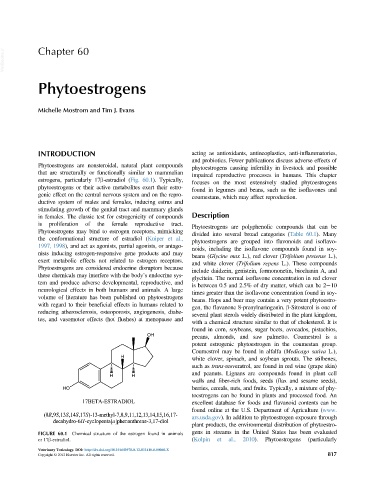Page 859 - Veterinary Toxicology, Basic and Clinical Principles, 3rd Edition
P. 859
VetBooks.ir Chapter 60
Phytoestrogens
Michelle Mostrom and Tim J. Evans
INTRODUCTION acting as antioxidants, antineoplastics, anti-inflammatories,
and probiotics. Fewer publications discuss adverse effects of
Phytoestrogens are nonsteroidal, natural plant compounds
phytoestrogens causing infertility in livestock and possible
that are structurally or functionally similar to mammalian
impaired reproductive processes in humans. This chapter
estrogens, particularly 17β-estradiol (Fig. 60.1). Typically,
focuses on the most extensively studied phytoestrogens
phytoestrogens or their active metabolites exert their estro-
found in legumes and beans, such as the isoflavones and
genic effect on the central nervous system and on the repro-
coumestans, which may affect reproduction.
ductive system of males and females, inducing estrus and
stimulating growth of the genital tract and mammary glands
in females. The classic test for estrogenicity of compounds Description
is proliferation of the female reproductive tract.
Phytoestrogens are polyphenolic compounds that can be
Phytoestrogens may bind to estrogen receptors, mimicking
divided into several broad categories (Table 60.1). Many
the conformational structure of estradiol (Kuiper et al.,
phytoestrogens are grouped into flavonoids and isoflavo-
1997, 1998), and act as agonists, partial agonists, or antago-
noids, including the isoflavone compounds found in soy-
nists inducing estrogen-responsive gene products and may
beans (Glycine max L.), red clover (Trifolium pretense L.),
exert metabolic effects not related to estrogen receptors.
and white clover (Trifolium repens L.). These compounds
Phytoestrogens are considered endocrine disruptors because
include daidzein, genistein, formononetin, biochanin A, and
these chemicals may interfere with the body’s endocrine sys-
glycitein. The normal isoflavone concentration in red clover
tem and produce adverse developmental, reproductive, and
is between 0.5 and 2.5% of dry matter, which can be 2 10
neurological effects in both humans and animals. A large
times greater than the isoflavone concentration found in soy-
volume of literature has been published on phytoestrogens
beans. Hops and beer may contain a very potent phytoestro-
with regard to their beneficial effects in humans related to
gen, the flavanone 8-prenylnaringenin. β-Sitosterol is one of
reducing atherosclerosis, osteoporosis, angiogenesis, diabe-
several plant sterols widely distributed in the plant kingdom,
tes, and vasomotor effects (hot flushes) at menopause and
with a chemical structure similar to that of cholesterol. It is
found in corn, soybeans, sugar beets, avocados, pistachios,
pecans, almonds, and saw palmetto. Coumestrol is a
potent estrogenic phytoestrogen in the coumestan group.
Coumestrol may be found in alfalfa (Medicago sativa L.),
white clover, spinach, and soybean sprouts. The stilbenes,
such as trans-resveratrol, are found in red wine (grape skin)
and peanuts. Lignans are compounds found in plant cell
walls and fiber-rich foods, seeds (flax and sesame seeds),
berries, cereals, nuts, and fruits. Typically, a mixture of phy-
toestrogens can be found in plants and processed food. An
excellent database for foods and flavanoid contents can be
found online at the U.S. Department of Agriculture (www.
ars.usda.gov). In addition to phytoestrogen exposure through
plant products, the environmental distribution of phytoestro-
FIGURE 60.1 Chemical structure of the estrogen found in animals gens in streams in the United States has been evaluated
or 17β-estradiol. (Kolpin et al., 2010). Phytoestrogens (particularly
Veterinary Toxicology. DOI: http://dx.doi.org/10.1016/B978-0-12-811410-0.00060-X
Copyright © 2012 Elsevier Inc. All rights reserved. 817

